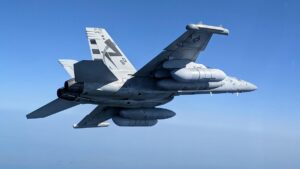The Chief of Naval Operations on Thursday said he was unsure if the future force would need a Medium Unmanned Surface Vessel at all and separately explained why the fiscal year 2023 budget seeks to retire ground-based EA-18G Growler aircraft.
By around 2030 “I think we’ll be in a better place with [the Large Unmanned Surface Vessel]. I don’t know if we’ll have a medium unmanned or not,” Adm. Michael Gilday said during an event at the Center for Strategic and International Studies.
The Navy has been working toward developing both Medium and Large Unmanned Surface Combatants, MUSV and LUSV. The Navy’s long-term shipbuilding plan, released last week, said MUSVs show promise for adding “substantial, distributed, low-cost forward sensors and C2 nodes” while LUSVs might be useful as a distributed weapons payload capacity.
Gilday said the unmanned surface vessel decisions will occur in the context with surface combatants and that Arleigh Burke-class Flight III DDG-51 destroyers “will pave the way [for future surface fleet capabilities] and 2030 is when we’re looking at DDG(X). And so I think that’ll be a three-year overlap with Flight III DDGs and DDG(X)…so we don’t put too much money on something…it’ll be a new hull and existing combat system.”
The Navy is planning to transition to a new large surface combatant to succeed the DDG-51s, called DDG(X), that will feature more space, weight, power and cooling capacity for future weapon capabilities, given that current destroyers have no remaining margin for major new weapons technologies.
Gilday said the kind of things that 5th Fleet Commander Vice Adm. Brad Cooper is doing with Task Force 59 (CTF-59), testing small unmanned systems on the sea and in the air “to sense the environment and to make sense of it in order to yield a common operational picture for allies and partners as well as 5th Fleet headquarters, has changed my thinking on the direction of unmanned.”
Last year, the task force was stood up to help enhance testing and integration of unmanned systems and artificial intelligence (AI) for use with the Navy to expand maritime domain awareness and increase deterrence forces (Defense Daily, Sept. 10).
CTF-59 finished its first exercise with U.S. and Bahrain naval forces by October (Defense Daily, Oct. 27, 2021) and hosted the seventh biennial International Maritime Exercise (IMX) starting in January as the largest unmanned exercise in the world with 80 unmanned systems (Defense Daily, Feb. 2).
“We are learning so fast in fielding these capabilities out to the fleet, potentially fielding them quickly inside the [five year Future Years Defense Program], we may be able to close capability gaps with small expendable unmanned off of any platform, rather than thinking that we have to build a larger unmanned vessel – there may be room for that,” Gilday said.
“I’m not saying that we don’t need an MUSV, I’m saying it’ll cause us to consider numbers and what potentially payloads you’re going to have,” he continued.
The CNO said unmanned systems coupled with AI software integration have much potential in general in future years and is unsure how many unmanned systems will be part of the future fleet.
“It’s difficult to put a definitive number on the numbers that we’re going to have in the air, on the sea or under the sea, I just think that there’s a lot of potential there. And I like the way we’re going with the Unmanned Task Force that’s tied together acquisition specialists, requirements folks, scientists from the Navy research labs, and also the fleet with CTF-59 in terms of real-time exercising, experimenting and developing [concepts of operations] – that it’s been a powerful eye-opening, awakening experience for us.”

The Navy currently operates and is testing several USV prototypes at Navy’s Surface Development Squadron One, including the Leidos [LDOS] Medium Displacement Unmanned Surface Vehicles (MDUSV) Sea Hunter and modified sister ship Sea Hawk.
Separately, Gilday explained why the Navy is seeking to retire 25 EA-18G Growler aircraft by 2025 in the FY ‘23 budget request. Budget documents said the Navy expects the divestments to save $808 million over the next five years (Defense Daily, April 18).
“We have small, five or six aircraft squadrons that we deploy in an expeditionary manner. We have one in Europe right now. It’s just not where I’d put my next dollar. And so I’m looking at carrier-based aviation, that’s what we do, that’s what we bring to the joint fight,” Gilday said.
The CNO added that there is nothing wrong with the Growler capability, which he called “awesome,” but “in a budget-constrained environment where I have to stratify stuff with respect to how the Navy’s going to contribute…but I need it integrated into an air wing at sea. So that’s what informed that decision to retire those squadrons.”